Detailed Research Report: Analysis of the Gero Crucifix Artwork
VerifiedAdded on 2021/04/16
|6
|1256
|341
Report
AI Summary
This research report provides a comprehensive analysis of the Gero Crucifix, one of the oldest surviving carved statues of Jesus, created around 970 A.D. under Archbishop Gero of Cologne. The report details the artwork's general specifications, including its size, location in the Cologne Cathedral, and its significance as a representation of Western Iconography. It explores the artist, patron, intended viewers, and original location, highlighting the crucifix's unique portrayal of Jesus Christ, carved from oak and partially gilded. The report examines the visual description of the artwork, its features, and its historical context within the Ottonian and Romanesque periods, comparing it to other contemporary artworks. The analysis includes a discussion of the crucifix's influence on later artworks and the cultural links between the Byzantine Empire and the Catholic Church. The report concludes with a list of cited works, providing a detailed and scholarly examination of the Gero Crucifix's artistic and historical importance.

Running head: RESEARCH REPORT ON ARTWORK
Research Report on Artwork
Name of the Student
Name of the University
Author Note
Research Report on Artwork
Name of the Student
Name of the University
Author Note
Paraphrase This Document
Need a fresh take? Get an instant paraphrase of this document with our AI Paraphraser
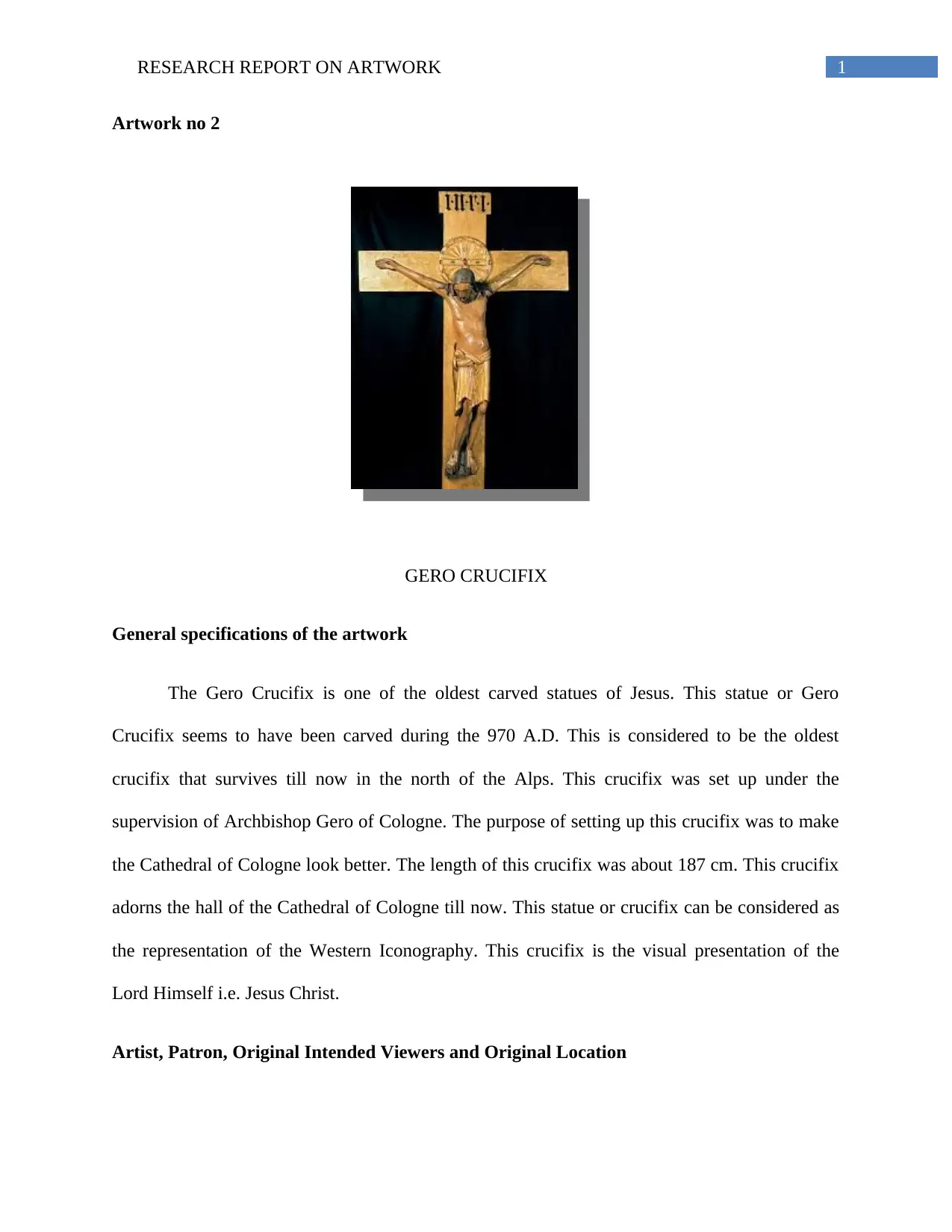
1RESEARCH REPORT ON ARTWORK
Artwork no 2
GERO CRUCIFIX
General specifications of the artwork
The Gero Crucifix is one of the oldest carved statues of Jesus. This statue or Gero
Crucifix seems to have been carved during the 970 A.D. This is considered to be the oldest
crucifix that survives till now in the north of the Alps. This crucifix was set up under the
supervision of Archbishop Gero of Cologne. The purpose of setting up this crucifix was to make
the Cathedral of Cologne look better. The length of this crucifix was about 187 cm. This crucifix
adorns the hall of the Cathedral of Cologne till now. This statue or crucifix can be considered as
the representation of the Western Iconography. This crucifix is the visual presentation of the
Lord Himself i.e. Jesus Christ.
Artist, Patron, Original Intended Viewers and Original Location
Artwork no 2
GERO CRUCIFIX
General specifications of the artwork
The Gero Crucifix is one of the oldest carved statues of Jesus. This statue or Gero
Crucifix seems to have been carved during the 970 A.D. This is considered to be the oldest
crucifix that survives till now in the north of the Alps. This crucifix was set up under the
supervision of Archbishop Gero of Cologne. The purpose of setting up this crucifix was to make
the Cathedral of Cologne look better. The length of this crucifix was about 187 cm. This crucifix
adorns the hall of the Cathedral of Cologne till now. This statue or crucifix can be considered as
the representation of the Western Iconography. This crucifix is the visual presentation of the
Lord Himself i.e. Jesus Christ.
Artist, Patron, Original Intended Viewers and Original Location
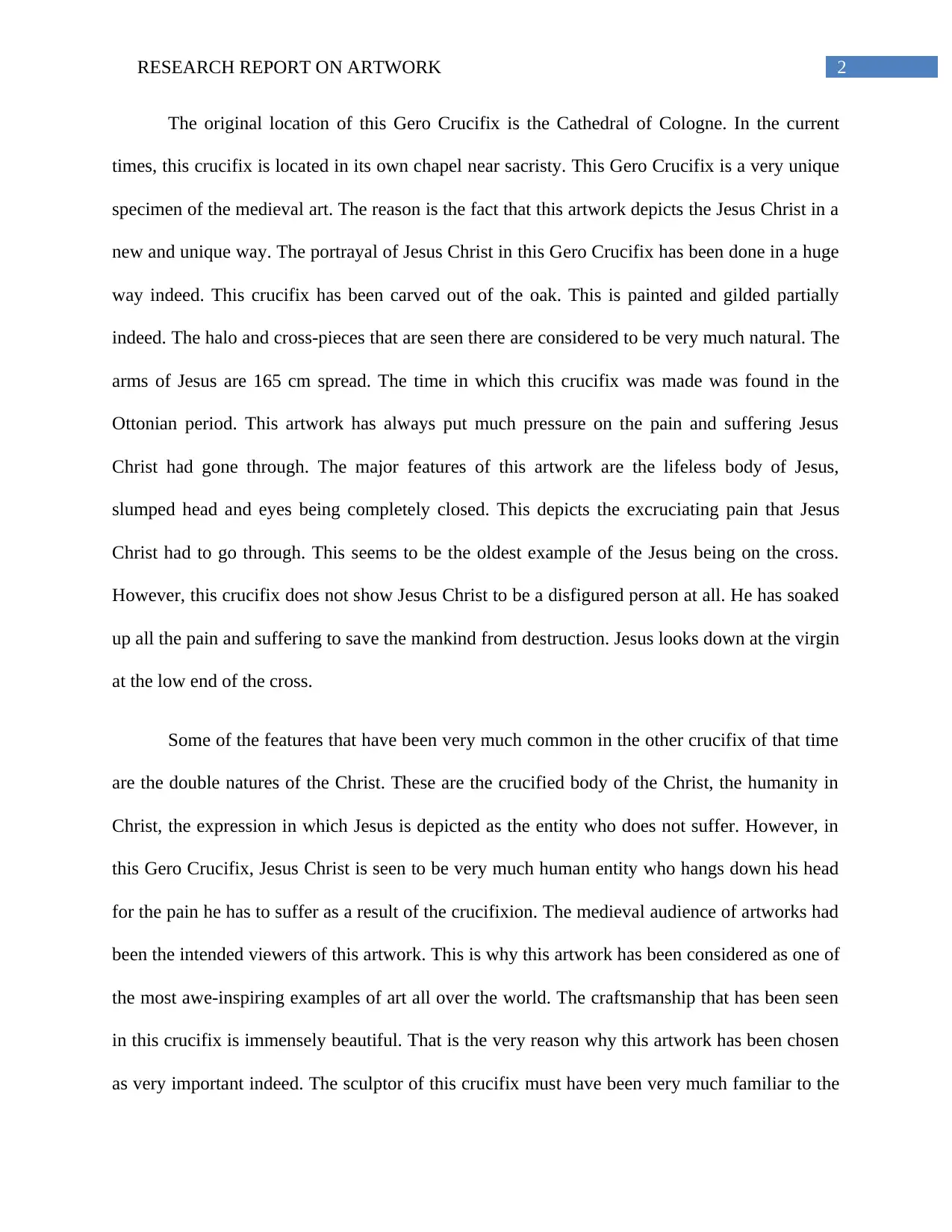
2RESEARCH REPORT ON ARTWORK
The original location of this Gero Crucifix is the Cathedral of Cologne. In the current
times, this crucifix is located in its own chapel near sacristy. This Gero Crucifix is a very unique
specimen of the medieval art. The reason is the fact that this artwork depicts the Jesus Christ in a
new and unique way. The portrayal of Jesus Christ in this Gero Crucifix has been done in a huge
way indeed. This crucifix has been carved out of the oak. This is painted and gilded partially
indeed. The halo and cross-pieces that are seen there are considered to be very much natural. The
arms of Jesus are 165 cm spread. The time in which this crucifix was made was found in the
Ottonian period. This artwork has always put much pressure on the pain and suffering Jesus
Christ had gone through. The major features of this artwork are the lifeless body of Jesus,
slumped head and eyes being completely closed. This depicts the excruciating pain that Jesus
Christ had to go through. This seems to be the oldest example of the Jesus being on the cross.
However, this crucifix does not show Jesus Christ to be a disfigured person at all. He has soaked
up all the pain and suffering to save the mankind from destruction. Jesus looks down at the virgin
at the low end of the cross.
Some of the features that have been very much common in the other crucifix of that time
are the double natures of the Christ. These are the crucified body of the Christ, the humanity in
Christ, the expression in which Jesus is depicted as the entity who does not suffer. However, in
this Gero Crucifix, Jesus Christ is seen to be very much human entity who hangs down his head
for the pain he has to suffer as a result of the crucifixion. The medieval audience of artworks had
been the intended viewers of this artwork. This is why this artwork has been considered as one of
the most awe-inspiring examples of art all over the world. The craftsmanship that has been seen
in this crucifix is immensely beautiful. That is the very reason why this artwork has been chosen
as very important indeed. The sculptor of this crucifix must have been very much familiar to the
The original location of this Gero Crucifix is the Cathedral of Cologne. In the current
times, this crucifix is located in its own chapel near sacristy. This Gero Crucifix is a very unique
specimen of the medieval art. The reason is the fact that this artwork depicts the Jesus Christ in a
new and unique way. The portrayal of Jesus Christ in this Gero Crucifix has been done in a huge
way indeed. This crucifix has been carved out of the oak. This is painted and gilded partially
indeed. The halo and cross-pieces that are seen there are considered to be very much natural. The
arms of Jesus are 165 cm spread. The time in which this crucifix was made was found in the
Ottonian period. This artwork has always put much pressure on the pain and suffering Jesus
Christ had gone through. The major features of this artwork are the lifeless body of Jesus,
slumped head and eyes being completely closed. This depicts the excruciating pain that Jesus
Christ had to go through. This seems to be the oldest example of the Jesus being on the cross.
However, this crucifix does not show Jesus Christ to be a disfigured person at all. He has soaked
up all the pain and suffering to save the mankind from destruction. Jesus looks down at the virgin
at the low end of the cross.
Some of the features that have been very much common in the other crucifix of that time
are the double natures of the Christ. These are the crucified body of the Christ, the humanity in
Christ, the expression in which Jesus is depicted as the entity who does not suffer. However, in
this Gero Crucifix, Jesus Christ is seen to be very much human entity who hangs down his head
for the pain he has to suffer as a result of the crucifixion. The medieval audience of artworks had
been the intended viewers of this artwork. This is why this artwork has been considered as one of
the most awe-inspiring examples of art all over the world. The craftsmanship that has been seen
in this crucifix is immensely beautiful. That is the very reason why this artwork has been chosen
as very important indeed. The sculptor of this crucifix must have been very much familiar to the
⊘ This is a preview!⊘
Do you want full access?
Subscribe today to unlock all pages.

Trusted by 1+ million students worldwide
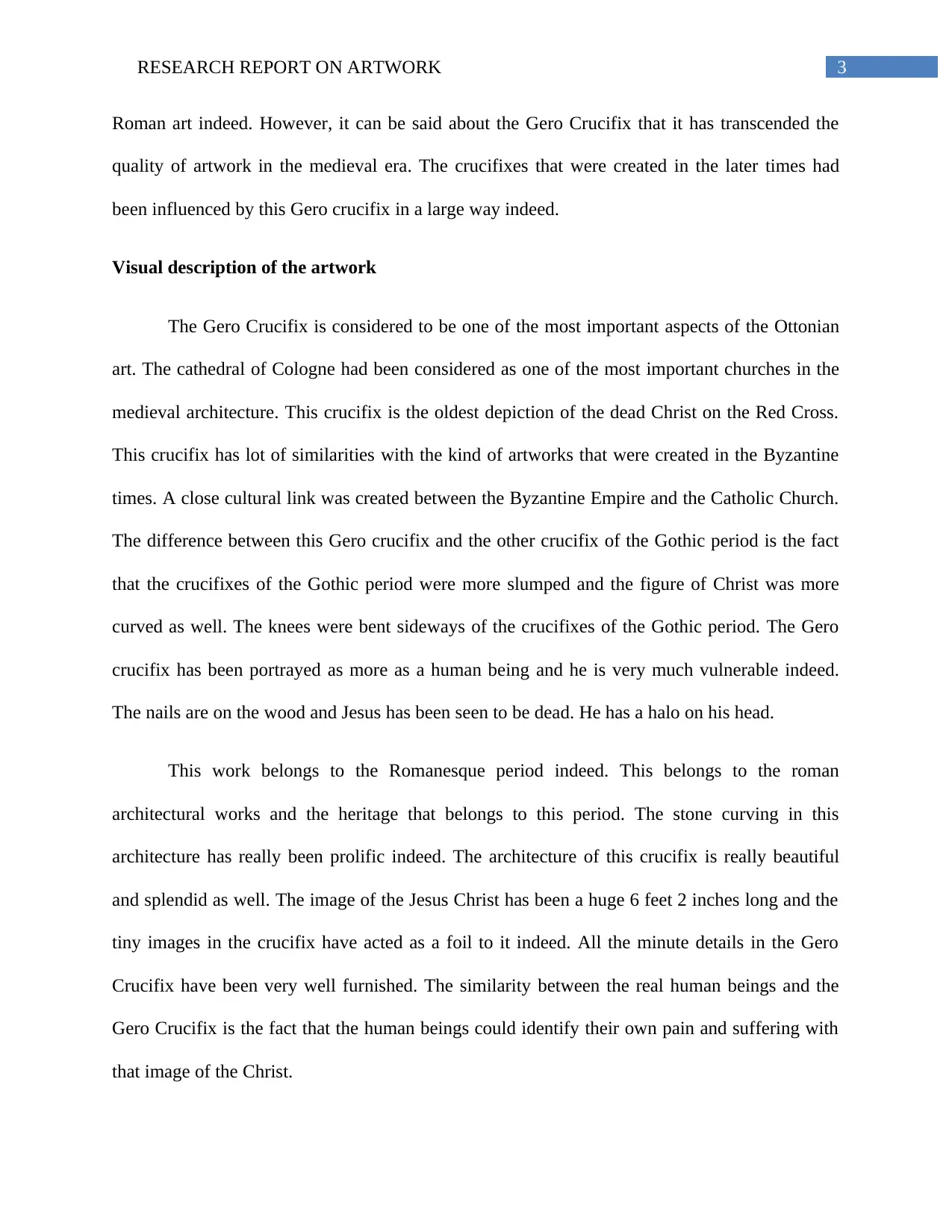
3RESEARCH REPORT ON ARTWORK
Roman art indeed. However, it can be said about the Gero Crucifix that it has transcended the
quality of artwork in the medieval era. The crucifixes that were created in the later times had
been influenced by this Gero crucifix in a large way indeed.
Visual description of the artwork
The Gero Crucifix is considered to be one of the most important aspects of the Ottonian
art. The cathedral of Cologne had been considered as one of the most important churches in the
medieval architecture. This crucifix is the oldest depiction of the dead Christ on the Red Cross.
This crucifix has lot of similarities with the kind of artworks that were created in the Byzantine
times. A close cultural link was created between the Byzantine Empire and the Catholic Church.
The difference between this Gero crucifix and the other crucifix of the Gothic period is the fact
that the crucifixes of the Gothic period were more slumped and the figure of Christ was more
curved as well. The knees were bent sideways of the crucifixes of the Gothic period. The Gero
crucifix has been portrayed as more as a human being and he is very much vulnerable indeed.
The nails are on the wood and Jesus has been seen to be dead. He has a halo on his head.
This work belongs to the Romanesque period indeed. This belongs to the roman
architectural works and the heritage that belongs to this period. The stone curving in this
architecture has really been prolific indeed. The architecture of this crucifix is really beautiful
and splendid as well. The image of the Jesus Christ has been a huge 6 feet 2 inches long and the
tiny images in the crucifix have acted as a foil to it indeed. All the minute details in the Gero
Crucifix have been very well furnished. The similarity between the real human beings and the
Gero Crucifix is the fact that the human beings could identify their own pain and suffering with
that image of the Christ.
Roman art indeed. However, it can be said about the Gero Crucifix that it has transcended the
quality of artwork in the medieval era. The crucifixes that were created in the later times had
been influenced by this Gero crucifix in a large way indeed.
Visual description of the artwork
The Gero Crucifix is considered to be one of the most important aspects of the Ottonian
art. The cathedral of Cologne had been considered as one of the most important churches in the
medieval architecture. This crucifix is the oldest depiction of the dead Christ on the Red Cross.
This crucifix has lot of similarities with the kind of artworks that were created in the Byzantine
times. A close cultural link was created between the Byzantine Empire and the Catholic Church.
The difference between this Gero crucifix and the other crucifix of the Gothic period is the fact
that the crucifixes of the Gothic period were more slumped and the figure of Christ was more
curved as well. The knees were bent sideways of the crucifixes of the Gothic period. The Gero
crucifix has been portrayed as more as a human being and he is very much vulnerable indeed.
The nails are on the wood and Jesus has been seen to be dead. He has a halo on his head.
This work belongs to the Romanesque period indeed. This belongs to the roman
architectural works and the heritage that belongs to this period. The stone curving in this
architecture has really been prolific indeed. The architecture of this crucifix is really beautiful
and splendid as well. The image of the Jesus Christ has been a huge 6 feet 2 inches long and the
tiny images in the crucifix have acted as a foil to it indeed. All the minute details in the Gero
Crucifix have been very well furnished. The similarity between the real human beings and the
Gero Crucifix is the fact that the human beings could identify their own pain and suffering with
that image of the Christ.
Paraphrase This Document
Need a fresh take? Get an instant paraphrase of this document with our AI Paraphraser
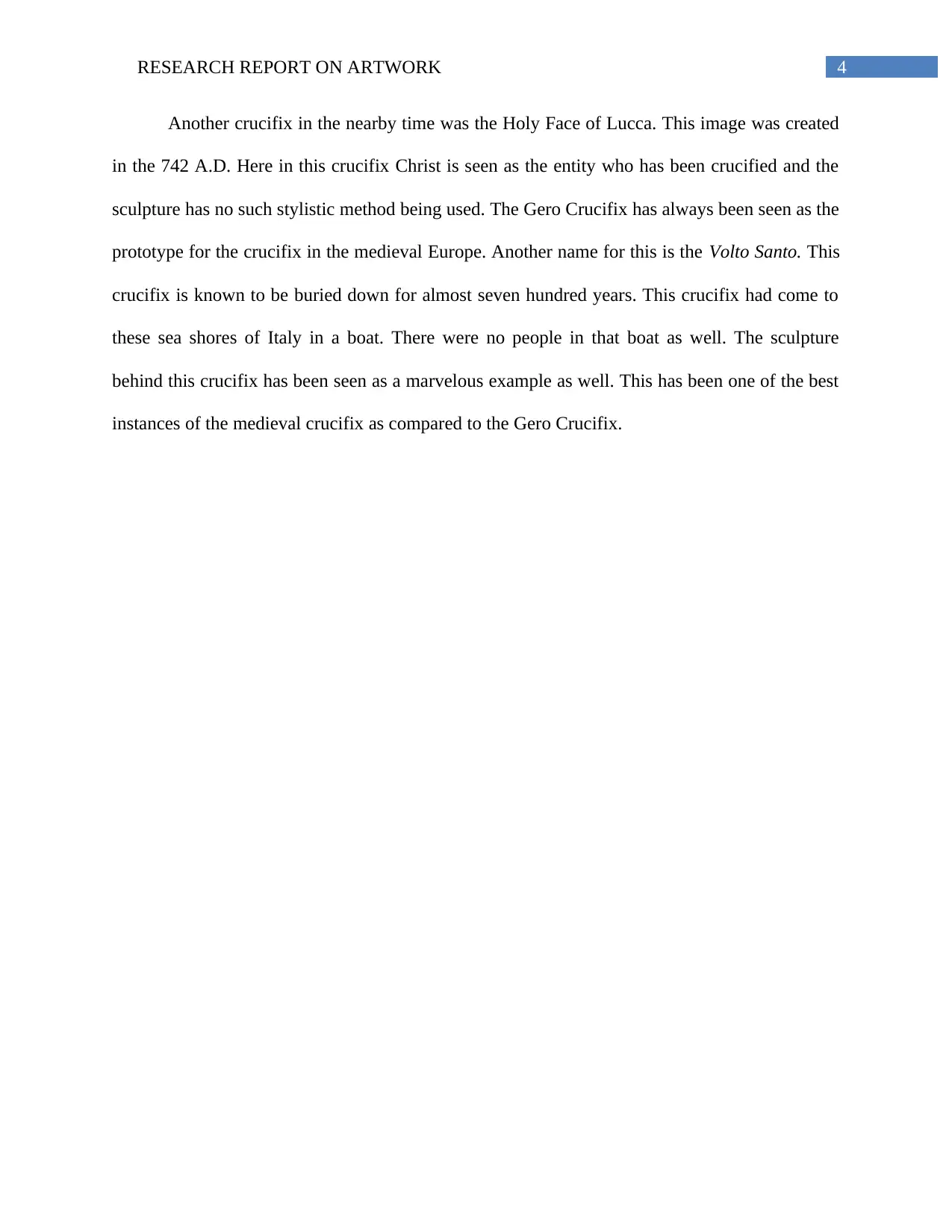
4RESEARCH REPORT ON ARTWORK
Another crucifix in the nearby time was the Holy Face of Lucca. This image was created
in the 742 A.D. Here in this crucifix Christ is seen as the entity who has been crucified and the
sculpture has no such stylistic method being used. The Gero Crucifix has always been seen as the
prototype for the crucifix in the medieval Europe. Another name for this is the Volto Santo. This
crucifix is known to be buried down for almost seven hundred years. This crucifix had come to
these sea shores of Italy in a boat. There were no people in that boat as well. The sculpture
behind this crucifix has been seen as a marvelous example as well. This has been one of the best
instances of the medieval crucifix as compared to the Gero Crucifix.
Another crucifix in the nearby time was the Holy Face of Lucca. This image was created
in the 742 A.D. Here in this crucifix Christ is seen as the entity who has been crucified and the
sculpture has no such stylistic method being used. The Gero Crucifix has always been seen as the
prototype for the crucifix in the medieval Europe. Another name for this is the Volto Santo. This
crucifix is known to be buried down for almost seven hundred years. This crucifix had come to
these sea shores of Italy in a boat. There were no people in that boat as well. The sculpture
behind this crucifix has been seen as a marvelous example as well. This has been one of the best
instances of the medieval crucifix as compared to the Gero Crucifix.
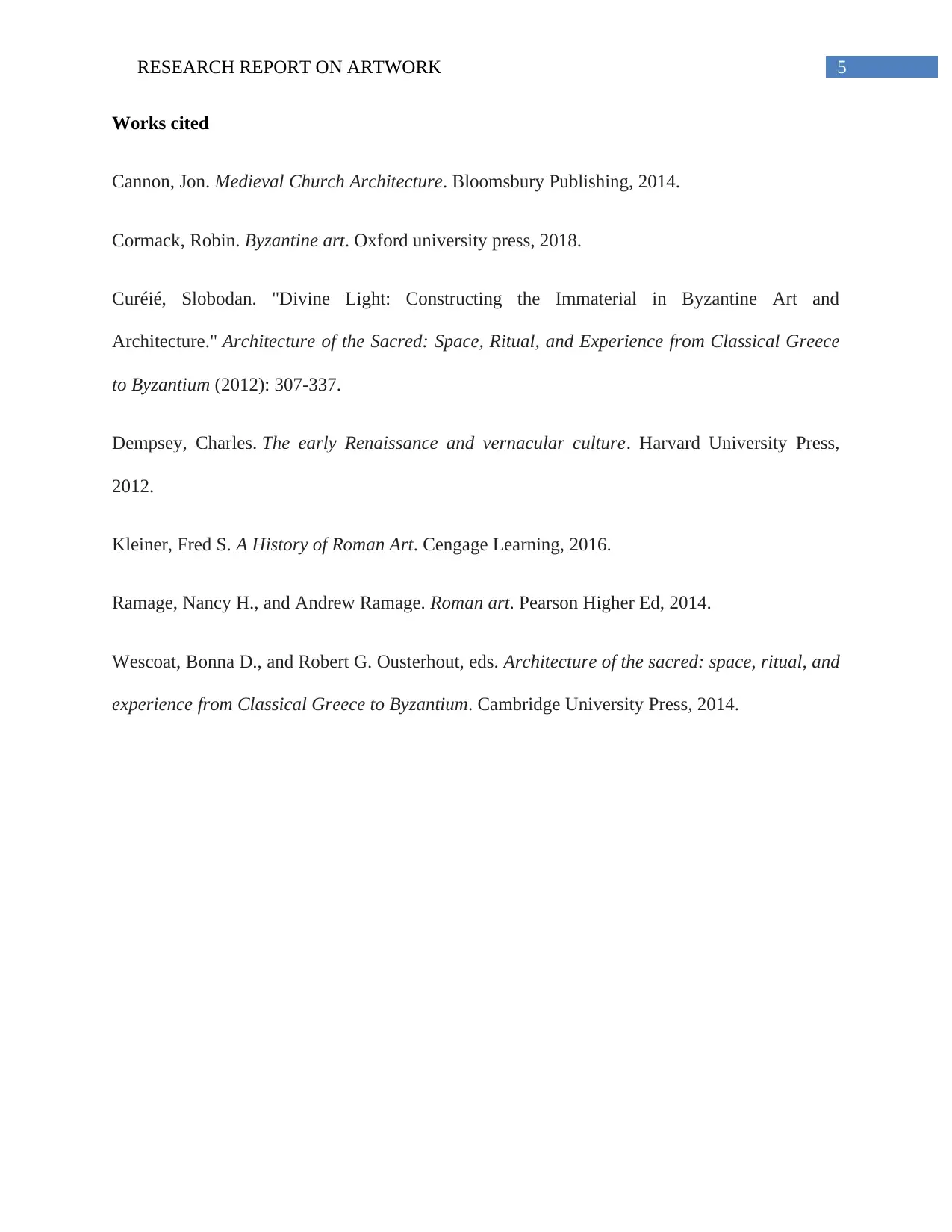
5RESEARCH REPORT ON ARTWORK
Works cited
Cannon, Jon. Medieval Church Architecture. Bloomsbury Publishing, 2014.
Cormack, Robin. Byzantine art. Oxford university press, 2018.
Curéié, Slobodan. "Divine Light: Constructing the Immaterial in Byzantine Art and
Architecture." Architecture of the Sacred: Space, Ritual, and Experience from Classical Greece
to Byzantium (2012): 307-337.
Dempsey, Charles. The early Renaissance and vernacular culture. Harvard University Press,
2012.
Kleiner, Fred S. A History of Roman Art. Cengage Learning, 2016.
Ramage, Nancy H., and Andrew Ramage. Roman art. Pearson Higher Ed, 2014.
Wescoat, Bonna D., and Robert G. Ousterhout, eds. Architecture of the sacred: space, ritual, and
experience from Classical Greece to Byzantium. Cambridge University Press, 2014.
Works cited
Cannon, Jon. Medieval Church Architecture. Bloomsbury Publishing, 2014.
Cormack, Robin. Byzantine art. Oxford university press, 2018.
Curéié, Slobodan. "Divine Light: Constructing the Immaterial in Byzantine Art and
Architecture." Architecture of the Sacred: Space, Ritual, and Experience from Classical Greece
to Byzantium (2012): 307-337.
Dempsey, Charles. The early Renaissance and vernacular culture. Harvard University Press,
2012.
Kleiner, Fred S. A History of Roman Art. Cengage Learning, 2016.
Ramage, Nancy H., and Andrew Ramage. Roman art. Pearson Higher Ed, 2014.
Wescoat, Bonna D., and Robert G. Ousterhout, eds. Architecture of the sacred: space, ritual, and
experience from Classical Greece to Byzantium. Cambridge University Press, 2014.
⊘ This is a preview!⊘
Do you want full access?
Subscribe today to unlock all pages.

Trusted by 1+ million students worldwide
1 out of 6
Your All-in-One AI-Powered Toolkit for Academic Success.
+13062052269
info@desklib.com
Available 24*7 on WhatsApp / Email
![[object Object]](/_next/static/media/star-bottom.7253800d.svg)
Unlock your academic potential
Copyright © 2020–2025 A2Z Services. All Rights Reserved. Developed and managed by ZUCOL.